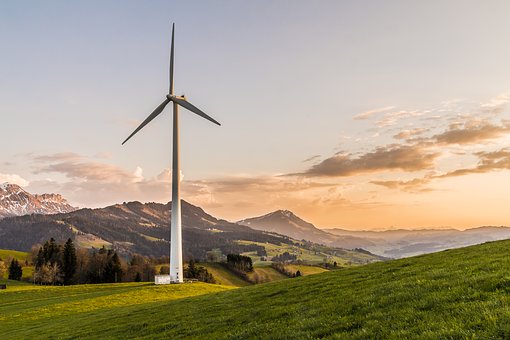

Wind power is a renewable energy source which has been around forever (well, a very very long time). Wind powered machines have been grinding grains for more than 2 millennia. Windmills pumping water in the Netherlands prevented much of the land becoming flooded and allowed for growing of fruit and tulips (Netherlands celebrates National Mill Weekend every year, opening windmills [and water mills] to the public). 1888 was the year the U.S. saw a wind turbine used for electricity generation, in Ohio, built by Charles Brush. Taller, skinny windmills have been used in the Australian outback to pump bore water from deep within the earth for almost 150 years. Given the very early use of wind power, we must assume that once again it’s quite simple. And yes, it is. The movement of air (wind) makes the blades turn, which then either connects directly to a generator or to an internal shaft and gearbox. Technology over the many generations since wind power was first used has obviously advanced, so we now have internal gears which increase the speed of blade rotation by a factor of 100. So why can’t we use this renewable source more, right now?
Unfortunately there are a few problems: firstly, often the best wind capturing sites are remote, far from the cities where the electricity is needed – so this poses difficulties (from both environmental and cost perspectives) in getting the electricity from the source; secondly, individual wind turbines don’t generate much electricity, so they really need to be placed in large (or very large) groups, called “wind farms”; this leads to the third argument of aesthetics/noise. However, if people love their view of nature, they should accept all things which will help arrest climate change (the biggest threat to any natural landscape). Research in Netherlands suggests that people are less likely to worry about the noise created if they have a financial stake – surely if we really thought about it, ‘financial stake’ would include ‘a stake in humankind’s future’, and that includes each and every one of us. Much research has been done on the health effects of wind turbine noise, and a recent literature review of 84 articles demonstrated no relationship between this noise and stress effects and biophysiological effects of sleep.
Interesting fact: if the mechanical energy is used to drive machinery (for grinding grain or pumping water) this is called a windmill. If the mechanical energy is converted to electricity, this is called a wind turbine.
Subjective opinions aside, we do still need to do some work on the efficiency of wind turbines. The average single wind turbine may have a capacity of 2.5 MW and could therefore produce 6 million kWh per year (enough to provide 1200 average U.S. households with electricity!), the ACTUAL production figures depend on the weather. The wind, to be specific. Some days are windier than others. And the turbines can only operate at optimal levels when wind speed is between 30-50 mph. When wind speed hits 55mph most turbines automatically shut down to prevent mechanical damage. This means that the average turbine has an efficiency of 30-59%. Of course this is less than ideal, but let’s add some perspective: the currently installed wind capacity in the U.S. avoids an estimated 189 million metric tons of CO2 emissions. To recap, due to current wind installations, 189 million metric tons of CO2 is NOT being released into the atmosphere. This number equates to 3% of total current U.S. CO2 emissions. So the reduction isn’t very much….except when you also look at the United States Government’s pledge (as per the Copenhagen Accord) to reduce emissions by 0-5% below 1990 figures. So….using the current installed wind capacity, the U.S. is actually halfway to reaching this (albeit, modest) goal!

Total installed capacity: 90,550 MW
So we call on all aspiring technicians and engineers to start working on increasing the efficiency of wind turbines. Because it’s not just hot air, this is one of the best renewable sources we have.




